Journal of Oceanography and Marine Research
Open Access
ISSN: 2572-3103
+44 1300 500008
ISSN: 2572-3103
+44 1300 500008
Research Article - (2020)Volume 8, Issue 1
The present comparative revise intends on providing qualitatively the mineral and vitamins by atomic absorption spectroscopy and high performance liquid chromatography respectively in total tissues of three Potamidid snails distinctively T. telescopium, C. obtusa and C. cingulata of Tekkali Creek, Srikakulam District, Andhra Pradesh. Fallouts illustrate that, elevated amounts of Iron, calcium and anticipated Phosphorous levels were existential in C. cingulata. C. obtusa had towering amount of magnesium, a lesser amount of sodium was observed in T. telescopium. Fairly accurate amounts of chlorine were observed in C. cingulata and C. obtusa. Lofty amount of penultimate macro element potassium perceived in C. obtusa. Last of all minerals, zinc concentration was far above the ground in C. cingulata. HPLC analysis of three Potamidid snail test samples showed the presence of high-flying concentrated vitamins. Elevated amount of vitamin A was observed in C. obtusa. Whereas C. cingulata had high amount of Vitamin E. Amongst B complex vitamins, B1 vitamin concentration is more in C. obtusa. C. cingulata had towering vitamin B2. T. telescopium had sky-scraping amount of vitamin B6, finally vitamin B12 concentration was lofty in C. obtusa. These findings demonstrate that the consumption of these tested bivalve snails, appends top worth-added essences.
Atomic absorption spectroscopy; High performance liquid chromatography; Cerithidea obtuse; Cerithidea cingulate; Telescopium telescopium
Flourishing acquaintance concerning the role of diet on human fitness is a developing trend leading to noteworthy discoveries and product developments in nutritional sector in larger scale [1]. In particular, studies and research on nutritionally important bioactive compounds has great attention to achieve advancements in current nutritional knowledge. There are several awareness programmes in society by proclaiming the role of nutritious food and its effect on overall health. Thus, the nutritious food generally classified as functional foods and various developmental studies are initiated to further enhance their nutritional qualities.
Molluscan fishery comprises an important component of the Indian sea food Industry. Although many species of the phylum mollusca are indigenous to the continent, the most important classes of commercial interest are the bivalves (oysters, clams, scallops and mussels), gastropods (conchs, whelks, abalones and periwinkles) and cephalopods (cuttle fish, squid and octopus) [2]. Fishery product is one of food productions contains a lot of nutrition; those are protein, fat, carbohydrate, vitamin, and mineral. One of fishery products contains essential nutrition is mollusc [3]. Aquatic animals are preferably utilized for the dietary source of minerals as they acquire minerals like copper, iron, potassium, magnesium, selenium, sodium and zinc from water to meet their physiological activities; howerver terrestial animals are primarily limited to dietary source of minerals [4]. Apart from these, phosphate and sulphates are generally obtained from feed sources for acquatic species [5].
Human body depends on a variety of essential nutrients like fat soluble vitamins (A, D, E and K), water soluble vitamins like B complex and ascorbic acid to perform its biologically important processes. Vitamins are a minor dietary constituent that are widely consumed although in small amounts in the daily diet [6]. It is well known that insufficient levels of vitamins can cause many problems in maintenance of body functions and normal growth [7]. For this reason, many foods are supplemented with vitamins, especially for infant and baby products in order to meet the nutritional requirements. In addition, the use of a multivitamin supplement is another way to circumvent the lack of sufficient dietary intake of vitamins and decrease the risk of hypovitaminosis, as a consequence of malabsorption, bad eating habits, pregnancy or acute and chronic diseases. Multivitamin supplements are also used for curing individual deficiencies [8].
Previously various investigators worked out on diverse group of mollusc species for their fat, water soluble vitamins and mineral profiles. All the above outcomes were in roughly accordance with preceding finding of Srilatha et al. who studied the proximate composition of Meretrix casta (Chemnitz) for its total protein, carbohydrate and lipid content in whole body tissues [9]. Similar studies were performed by Swapna and Ravinder to assess the nutritional qualities of Parreysia cylindrica of the Waddepally and Kaleshwaram in two different lakes [10]. Periyasamy et al. premeditated the proximate composition of Bivalve Donax incarnates for the estimation of biochemical components [11]. Albena et al. worked out on wild black sea mussel, rapana and shrimp for their fatty acid composition and fat soluble vitamins in view to determine and compare total lipids, fat soluble vitamin content, fatty acid composition and lipid-quality indices as atherogenic, thrombogenic and flesh-lipid quality index of these molluscs from Bulgarian Black Sea coast [12]. Gopalsamy et al. exertioned out on Donax cuneatus biochemical components composition [13]. Recently Joseph and Ramesh demonstrated a work concerning the fatty-acid profiles of three Potamidid snails namely Telescopium telescopium, Cerithedia obtusa and Cerithedia cingulata and their findings concluded that these snails can be utilized as potential fishery resource for nutrition [14].
In recent years there has been increasing recognition of the beneficial direct impacts of marine ecosystems and biodiversity on human health [15]. But, compared with terrestrial ecosystems, the links between marine ecosystems and human health have been far less studied and the historical baseline of information is brief. Expanding scientific and research progress from the past two decades in the field of nutritional importance of diet have shown the incredible potentiality of foods to improve health [16]. Hence there is a greater interest in nowadays among consumers and products of different food industries to promote health and well-being.
The present work is designed on providing the mineral and vitamins concentrations in the total tissues of three Potamidid snails specifically Telescopium telescopium, Cerithidea obtusa and Cerithidea cingulata of Tekkali Creek, Srikakulam District, Andhra Pradesh.
Sample collection
The cram study area geographically located at Long: 18° 33' 52'' to 18° 32' 11'' N; Lat: 84° 21' 26'' E to 84° 18' 22'' E. Specific area map was displayed in Figure 1. Three gastropods representing two genera namely Telescopium telescopium (Figure 2a), Cerithidea obtusa (Figure 2b) and Cerithidea cingulata (Figure 2c) within the family of Potamididae were collected during the low tide from tidal mudflats of Bhavanapadu mangroves, Srikakulam District, Andhra Pradesh province, India. These gastropod molluscs were identified up to species level following the appropriate field guides of Antony and Oliva and Dey basing on the morphology [17,18]. These samples were brought to the laboratory in zip pouches and then washed thoroughly with distilled water. The soft tissues were dissected from the hard shells with the help of bone cutter and finally stored in refrigerator at 4°C for further use.
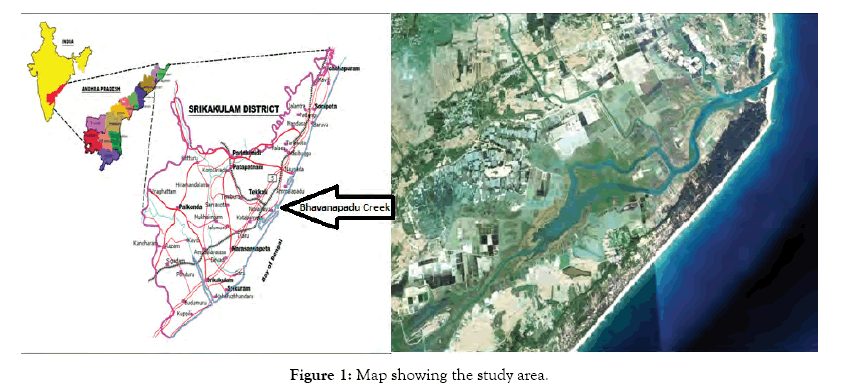
Figure 1: Map showing the study area.
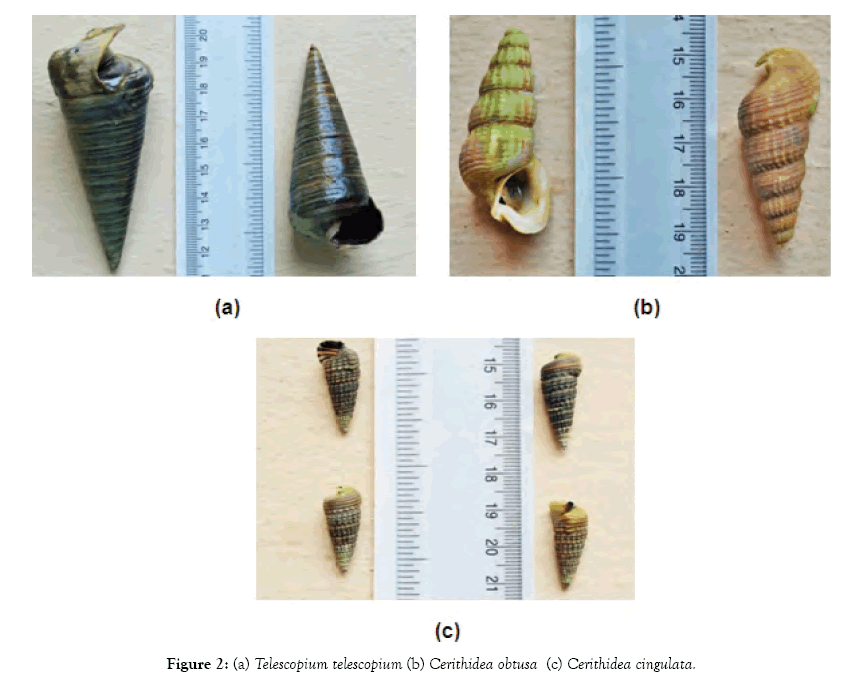
Figure 2: (a) Telescopium telescopium (b) Cerithidea obtusa (c) Cerithidea cingulata.
Estimation of minerals by atomic absorption spectroscopy
For the estimation of minerals, the collected soft tissue from snails was first dried in dessicator at 60°C. The dried tissue was then grinded into fine powder in a mortar and pestle. The obtained powder was used for further analysis and estimation of minerals by atomic absorption spectrophotometer (Varian 220 Spectra AA, Australia Pvt. Ltd.) according to the di-acid digestion method by using nitric acid (HNO3) and perchloric acid (HClO4) with suitable modifications [19]. The method starts with the addition of concentrated HNO3 (7 ml) to the sample (2 g) which is placed in digestion tubes followed by overnight digestion in a fume hood up to no brown fumes were observed. The digestion was further continued by the addition of perchloric acid (6 ml) up to the colorless solution was observed. Then the solution was cooled and filtered through Whatman No. 1 filter paper. The obtained filtrate was diluted with 50 ml of distilled water for sample injection and determination of minerals by atomic absorption spectrophotometer. The analysis of minerals Ca, Na, K, Fe, Mg and Zn was performed by flame absorption spectrophotometry with deuterium cathode lamp. Calibration curves were generated with multilevel calibration standards, meanwhile phosphorous content was analyzed by alkalimetric ammonium molybdophosphate method as per AOAC official method 964.06 [20].
Estimation of vitamins by HPLC
Fat soluble vitamins were estimated by modified method of Salo- Vaananen [21]. The vitamin stock standards (Sigma-Aldrich Chemical Co. Inc, St. Louis, MO) were prepared (1, 10, 25, 50 and 100 ppm) for the construction of standard curve by HPLC. All the stock solutions were stored at -20°C. A mixed standard solution of 11 vitamins was used for qualitative and quantitative analysis as follows.
Mixed vitamin standard solution
Mixed standard solutions of 11 vitamins at different concentrations were prepared by using a water-methanol solution (50:50, v/v). The composition of the mixed solution is given in Table 1.
| S. No | Vitamins | Vitamin content in mixed solutions (mg/L) |
|---|---|---|
| 1 | Retinol acetate (Vitamin A) | 10 |
| 2 | Cholecalciferol (Vitamin D3) | 5 |
| 3 | α-tocopherol (Vitamin E) | 10 |
| 4 | Phytonadione (Vitamin K1) | 5 |
| 5 | Thiamine (Vitamin B1) | 10 |
| 6 | Riboflavin (Vitamin B2) | 10 |
| 7 | Niacin (Vitamin B3) | 15 |
| 8 | Cyanocobalamin (Vitamin B 12) | 20 |
| 9 | Ascorbic acid (Vitamin C) | 10 |
| 10 | Folic acid (Vitamin B9) | 20 |
| 11 | p-aminobenzoic acid (PABA) | 10 |
Table 1: Mixed vitamin standard references.
A retention time of pure substances was performed for qualitative analysis; quantitative analysis was performed by calibrating chromatographic peak areas of corresponding standards [22]. Water soluble vitamins were analyzed by the method described by Sadasivam and Manickam which includes analysis of methanolic extracts of homogenized soft tissue [23]. Whereas the lipids were extracted using established method Bligh and Dyer, hydrolysis of sample was performed with KOH or MeOH followed by extraction with petroleum ether and washed with distilled water [24]. The non-saponifiable matter was concentrated using rotary evaporator (Heidolph, Germany), reconstituted in methanol, filtered and injected (20 μl) in HPLC (Scimadzu, Prominence) equipped with C 18 column. The run time was 45 min and the eluents were detected at 265 nm with the flow rate 1 ml/min. The vitamins were expressed as mg/100 grams of fresh wet sample.
All the estimated macro and micro elements were expressed in mg/100 grams of extract and the values were means of triplicate with ± standard deviations. Elevated amount of Iron (Fe) was empiric in C. cingulata with 3.41 ± 0.38 and a reduced amount was observed in C. obtusa with 1.87 ± 0.09 and moderate level was pragmatic in T. telescopium with 2.71 ± 0.11. Lofty amount of calcium was pragmatic in C. cingulata with 328.69 ± 11.93 and reasonable and a smaller amount were observed in T. telescopium and C. cingulata by 273.33 ± 19.01 and 249.33 ± 11.15 in that order. Phosphorous levels pointed out C. cingulata had high, C. obtusa had moderate and T. telescopium had less amounts, that is 328.45 ± 11.84, 262.13 ± 12.20 and 232.33 ± 10.26 correspondingly. C. obtusa had towering amount of magnesium with 41.67 ± 0.77, restrained amount in T. telescopium by 33.13 ± 2.03 and a reduced amount that is 28.15 ± 1.61 was observed in C. cingulata. A lesser amount of sodium 17.60 ± 0.93 was observed in T. telescopium, elevated amount 26.14 ± 1.79 was observed in C. obtusa and restrained amount 24.75 ± 1.82 was found in C. cingulata. Fairly accurate amounts of chlorine were observed in C. cingulata and C. obtusa by 21.85 ± 2.65 and 21.28 ± 1.69 respectively. Whereas very less amount of 12.74 ± 1.69 was observed in T. telescopium. Penultimate macro element potassium was moderate and less in T. telescopium and C. cingulata, whereas C. obtusa had high amount of Potassium that is 354.33 ± 29.09, 166.69 ± 16.49 and 468.00 ± 16.52 proceedingly. Last of all minerals, zinc (Zn) concentration was far above the ground in C. cingulata with 32.88 ± 1.81, smaller amount 18.67 ± 1.23 was noticed in C. obtusa and moderate amount 26.87 ± 2.11 was observed in T. telescopium. All the above fallouts were put on show in Table 2.
| S. No. | Name of the Mineral | T. telescopium | C. obtusa | C. cingulata |
|---|---|---|---|---|
| 1 | Iron | 2.71 ± 0.11 | 1.87 ± 0.09 | 3.41 ± 0.38 |
| 2 | Calcium | 273.33 ± 19.01 | 249.33 ± 11.15 | 328.69 ± 11.93 |
| 3 | Phosphorous | 232.33 ± 10.26 | 262.13 ± 12.20 | 328.45 ± 11.84 |
| 4 | Magnesium | 33.13 ± 2.03 | 41.67 ± 0.77 | 28.15 ± 1.61 |
| 5 | Sodium | 17.60 ± 0.93 | 26.14 ± 1.79 | 24.75 ± 1.82 |
| 6 | Potassium | 354.33 ± 29.09 | 468.00 ± 16.52 | 166.69 ± 16.49 |
| 7 | Chlorine | 12.74 ± 1.69 | 21.28 ± 1.69 | 21.85 ± 2.65 |
| 8 | Zinc | 26.87 ± 2.11 | 18.67 ± 1.23 | 32.88 ± 1.81 |
Table 2: Micro and macro nutrient profiles by means of atomic absorption spectroscopy.
Together with the mineral contour, HPLC analysis of three Potamidid snail samples namely Telescopium telescopium, Cerithidea obtusa and Cerithidea cingulata for their water soluble and fat soluble vitamins, showed the presence of high-flying concentrated vitamins.
An elevated amount of vitamin A that is 108 IU was observed in C. obtusa and less amount 58 IU was practical in T. telescopium and moderate amount 94 IU was pragmatic in C. cingulata. whereas C. cingulata had high amount of Vitamin E with 7.7 mg/100 grams of extract and a lesser amount factual in C. obtusa with 4.5 mg/100 grams of extract and reasonable amount was experimental in T. telescopium with 6.2 mg/100 grams of extract. Amongst B complex vitamins, B1 (Thiamin) vitamin concentration is more in C. obtusa with 0.13 grams/100 grams of extract whereas not as much amount was observed in C. cingulata by 0.07 grams/100 grams of extract and sensible amount 0.11 grams/100 grams of extract was pragmatic in T. telescopium. C. cingulata had towering vitamin B2 (Riboflavin) that is 0.25 grams/100 grams of extract, whereas C. obtusa had modest amount with 0.23 grams/100 grams of extract and fewer amount 0.19 grams/100 grams of extract was observed in T. telescopium. T. telescopium had sky-scraping amount of vitamin B6, to be precise 0.11 grams/100 grams of extract and a smaller amount 0.06 grams/100 grams of extract was observed in C. cingulata, while sensible amount 0.08 grams/100 grams of extract was observed in C. obtusa. Finally, vitamin B12 (Cobalamine) concentration was lofty in C. obtusa and fair in T. telescopium and a smaller amount in C. cingulata, concentrations were 0.011, 0.009 and 0.004 grams/100 grams of extract in that order. All the outcomes were displayed in Table 3 and Figures 3a-3d.
| Vitamins | T. telescopium(mg/100 g) | C. obtusa (mg/100 g) | C. cingulata (mg/100 g) | |
|---|---|---|---|---|
| Retinol acetate (Vitamin A) | 58 IU | 108 IU | 94 IU | |
| Cholecalciferol (Vitamin D3) | - | - | - | |
| α-tocopherol (Vitamin E) | 6.2 | 4.5 | 7.7 | |
| Phytonadione (Vitamin K1) | ||||
| Thiamine (Vitamin B1) | 0.11 | 0.13 | 0.07 | |
| Riboflavin (Vitamin B2) | 0.19 | 0.23 | 0.25 | |
| Niacin (Vitamin B3) | - | - | - | |
| Cyanocobalamin (Vitamin B 12) | 0.009 | 0.011 | 0.004 | |
| Ascorbic acid (Vitamin C) | - | - | - | |
| Folic acid (Vitamin B9) | - | - | - | |
| p- Aminobenzoic acid (PABA) | - | - | - | |
Table 3: Vitamin profile in three species by HPLC.
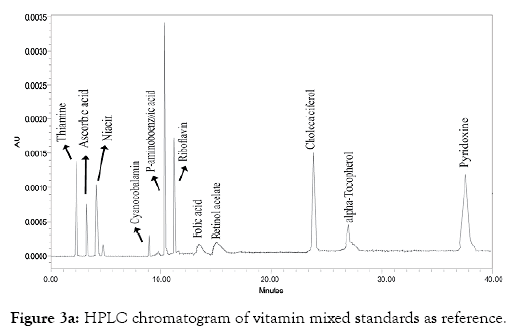
Figure 3a: HPLC chromatogram of vitamin mixed standards as reference.
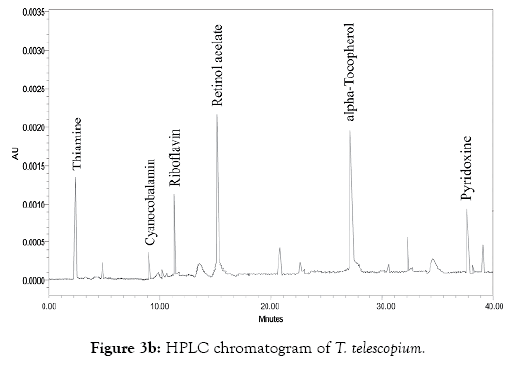
Figure 3b: HPLC chromatogram of T. telescopium.
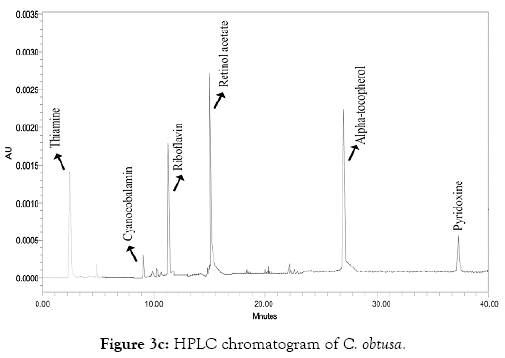
Figure 3c: HPLC chromatogram of C. obtusa.
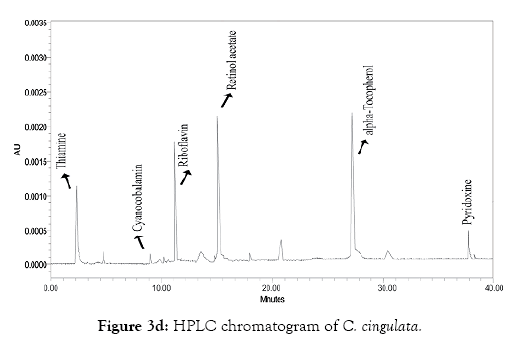
Figure 3d: HPLC chromatogram of C. cingulata.
All over the world, Molluscs are recognized as high quality nutritious food source. Till date, majority of the nutritional research occurred from bivalves and cephalopods, besides, only a meagre part was covered in gastropods. After proteins and lipids, the next most dominant organic components are minerals and vitamins. The discrepancy in the composition of different mineral components in test samples is due to their availability in the water body and; their ability to get absorbed from water or through feed [25]. Iron is a vital nutrient which performs very important functions like oxygen delivery to tissues, component of important proteins like hemoglobin, cytochromes, myoglobin etc., [26]. Calcium and phosphorous are the important constituents of inorganic portion of feed and they are responsible for structural components of hard tissues like bone, exoskeleton, teeth etc., In particular calcium plays an important role in blood clotting, muscle contraction and nerve impulse transmission as per National Research Council in 1993 [4]. Phosphorous has gained its significance by being a component of nucleic acids and components of biological buffers [27]. Magnesium is another crucial nutrient which is involved in more than 300 enzymatic reactions of various physiological metabolic reactions. It also performs its important role as physiologic regulator for membrane stability [28]. Significance of sodium, chloride and potassium is due to their vital functions in number of physiological processes [4]. The human daily intake of sodium is 2.3 grams and for potassium, it is 3 grams recommended by National Health and Medical Research Council which corresponds to 100 grams’ meat of these snails [29]. Sodium is an important extracellular cation which regulates blood volume, blood pressure and osmotic equilibrium. Potassium is important in maintaining fluid balance. Sodium and chloride are the two important extracellular electrolytes which maintain charge differences across the membranes and thus plays a crucial role in life sustaining process [30]. Zinc is essential for the activity of several enzymes, hormonal regulation, reproduction, wound healing and also in immunity [31]. Hence zinc deficiency is associated with several problems like hair loss, poor immunity, poor growth and skin problems etc., [32]. The potamidid snails, T. telescopium and C. cingulata in this study contribute a good zinc content which is necessary for daily intake. The previous literature reveals that zinc content varies with different species i.e., cockles 8.06 mg/kg and mussels 21.2 mg/kg in molluscs by which it supports the idea that the level of mineral content fluctuates with the organism relying on the nature of food they prey on [33,34]. Likewise, scanty works have been documented on the nutritional composition of marine gastropods in turbinids and muricids and, indicated that these snails provides a good source of essential elements [35-37].
Fat soluble vitamins, especially estimated Vitamins A and E perform very important functions. Vitamin A is essential for normal vision, gene expression, immunity and maintenance of epithelial cell functions [26]. Vitamin E is well known for its antioxidant effect which maintains integrity of cellular membranes and induces response to oxidative stress [38,39]. Its deficiency is primarily associated with neurologic damage and erythrocyte hemolysis [40]. Thaimin participates and plays a key role in carbohydrate and protein metabolism [32]. Riboflavin being a coenzyme of flavoproteins participates in mitochondrial electron transport system and thus required for oxidative energy production [41]. Pyridoxine performs key steps in different metabolic pathways of carbohydrate metabolism [42]. Cobalamin is essential for the formation of normal erythrocytes and neurological functions [43]. From the outcomes of the present study, it is noteworthy to mention that vitamins A and E are sufficient to meet the daily vitamin need of humans as per the recommendations given by Belitz et al. [44-46].
To date, the impact of the utilization of these nutrient rich molluscs as chow has not attracted much attention. The outcome of the present study provides information about the mineral and vitamin composition and also suggest the consumption of these potamidid snails specifically T. telescopium, C. obtusa and C. cingulate adds top value-added substances. Additionally, promote the development of novel food sources and for the formulation of food supplements for the revival from malnutrition.
The authors would like to acknowledge Union Grants Commission - Maulana Azad National Fellowship, New Delhi, India for providing financial support to carry out this work.
Citation: Uday Ranjan TJ, Babu KR (2020) Epidemiological and Nutritional Perspectives of Three Mangrove Snails- Telescopium telescopium, Cerithidea obtusa and Cerithidea cingulata - A Relative Exploration of Minerals and Vitamins. J Oceanogr Mar Res 8:197. doi: 10.35248/2572-3103.20.8.197
Received: 12-Dec-2019 Accepted: 19-Feb-2020 Published: 26-Feb-2020 , DOI: 10.35248/2572-3103.20.8.197
Copyright: © 2020 Uday Ranjan TJ, et al. This is an open-access article distributed under the terms of the Creative Commons Attribution License, which permits unrestricted use, distribution, and reproduction in any medium, provided the original author and source are credited.